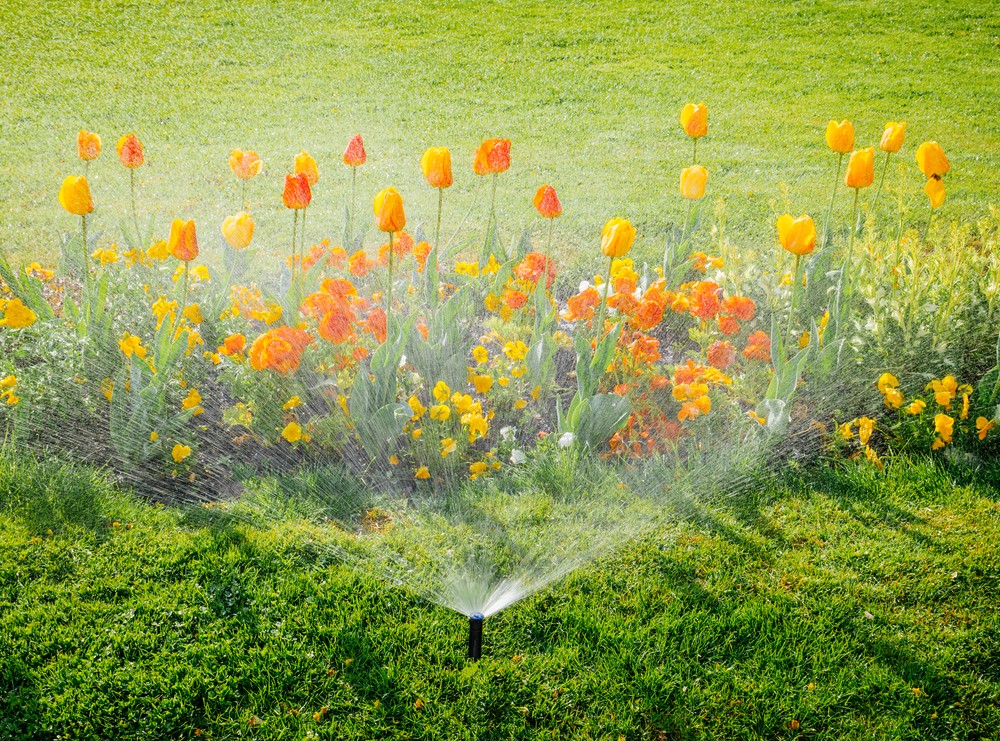Conserving water is very important, but does it have to be at the expense of a pleasant garden. No, you can be environmentally responsible and have a very healthy, green garden if you follow a few simple tips.
#1. Good, open, friable soil. You may or may not be blessed with good soil in your garden – but if not then you can make it better – it’s the key to a Waterwise Garden. Plants need both room to move and moisture to grow well, so ensure you have plenty of organic or composted natural materials in your soil. This keeps the soil open and allows water to penetrate but the natural fibres of the humus retain moisture to make them available over an extended period by the plants. Plants can’t gulp water like we can, when you water your garden it will take many hours or even days for it to get into the roots – therefore you have to ensure that it’ll stay there without water logging the soil to allow the plant to drink. Lucerne, straw, leaf mulch, chopped up hedge clippings, compost, peat, sawdust, paper and cardboard, animal manures and even seaweed all help to maintain moisture – all even better if they have been composted naturally for a while. Dig it in, or spread it on and let the worms take it down – the former will obviously be more effective but the latter is OK for those with bad backs. Lawns especially need loosening up and additions of compost – just spread it lightly over and open up the soil with a fork – the worms will do the rest. Lawns can also provide their own thermal blanket if you set your mower a little higher in the summer to keep a good thatch of grass to protect the grass roots.
#2. Mulch . This one should be a mandatory for every garden – in fact if we had to have a license to run a garden (like we do a car) then I’d be in favour of garden licenses only being issued to gardeners who apply lots of mulch. Yes, I know that’s not the way we do things in Australia – but hey, it’s not a bad idea is it? Most of the water we pour into our gardens runs off or evaporates before the plants can get to it. Mulching, involving covering any bare soil with a 10-15cms blanket of natural materials like bark, woodchips, straw, compost, leaf litter and even gravel – will act like a thermal barrier, keeping the soil cooler when the weather is hot, and keeping the moisture in. The plants like a more consistent environment for their roots and the water you sprinkle on stands a better chance of being there when the plant is able to suck it in. Natural materials like bark or woodchip will also slowly break down (naturally compost) and the worms will take that down into the soil (that’s good, see previous point). So that means you must top up your mulch every year (unless you use gravel of course).
N.B. Some folks used to use black plastic sheets – um, not good as it has the opposite effect and also acts as a barrier to rain. Good against weeds, otherwise it’s as dumb as you can get.
#3. Wetting agents. If you have a very sandy or volcanic soil the water can run through it so quickly it’s almost not worth watering. This is often made worse by the surface tension of these soils almost repelling water – you might even see it run off in blobs rather than soak in. Wetting agents break down that surface tension and help the water droplets wrap around each sand grain letting the water stick around a bit longer to get absorbed by your plant’s roots. N.B. if your soil is very sandy you really should also get some organic materials into it as well and not just rely upon wetting agents.
#4. Water crystals are made from granular, super absorbent polymer. Sometimes referred to as hydrogels or polymer crystals, these small granules absorb and store water – up to 400 times its original density. When tilled into the soil, water crystals will absorb and retain excess water for extended periods. The extent of time depends on ambient temperature, humidity and the thirst of the plant(s). In all cases, water crystals increase the availability of water to plants and conserve water whilst being environmentally safe.
Fact: Water crystals reduce watering frequency – by 50 – 75% in potted plants, by 15 – 40% on lawns and 20 – 40% in veggie patches.
#5. Hand Watering: In many states of Australia this is the only way to water responsibly. Do it carefully, lots of small doses are better than one big soak. Water early in the morning when it’s cool and the plants are most able to take up the moisture, not in the evening when the plants may be a bit heat stressed after a hot day. Like humans a sudden cooling is not necessarily good. Check your hoses and irrigation pipes often – leaks account for more wasted water than almost anything else. Never leave sprinklers on – it’s just not doing any good at all – a gentle spray with a hose as you walk around works best – particularly if you do two circuits, one to moisten the top soil, then anther spray ten minutes later will get more water down to the roots than one prolonged spray. Walking round the garden twice is so much better than fixing a hose or a sprinkler.
#6. Irrigation: When set up properly irrigation can be very waterwise as it gets water only to the places you need it, and usually in smaller, elongated doses. Fine sprays are good unless you live in a windy spot – drip irrigation is best – directly to the roots in the smallest of doses – as are underground seeper hoses. These are made from recycled rubber and carry the water along a traditional pipe but it also leaks out of the many tiny cracks when the pressure is high enough. Once again the amounts of water are minimised and get right to the roots while minimising run-off.
#7. Grey Water: Use of household waste water is a way to earn lots of environmental brownie points. Bath, shower, washing machine or dishwasher water rarely has enough detergents in it to do any lasting damage – especially if you use them sparingly anyway (which is a doubly responsible thing to do anyway). However getting the water onto the garden may present a few logistical problems – we won’t go into that now, if you are that keen, you’ll find a way.
#8. Water Tanks: Our view here at GardensOnLine is that any new house shouldn’t get a council clearance unless it has water tanks to collect rainwater. (Yup, we are dreaming I’m sure, but you have to dream sometimes to make reality happen). Some local authorities are now offering rebates on water tank equipment to encourage more folks to use them. Regardless of whether you have thinking politicians or not, take the initiative yourself and install a good old waterbutt. You’ll save huge amounts of piped water, especially on the east coast when it rains a lot during the warmer weather. It’s still worth it in Western Australia too – you’ll collect enough to make a difference – and that’s everyone’s task in life – to make a difference, no matter how small.
#9. Don’t Waste Water in the Garden: Don’t even think about hosing down the pathways – its much quicker with a broom and also forget about hosing down the car – use a bucket, your car will not be any less clean afterwards! If you have a pool, check all pipes often and backwash often for short periods, you’ll use less water and need to top up the pool less.
There are some inescapable facts – the more people, the less our man-made water systems can supply to each of us. Dams don’t get built very often but houses do – it’s simple supply and demand.
Is it getting hotter, is the planet warming up? It does seem to be. And if all this global scale stuff makes you feel totally helpless to make a difference – then think again. No one human can make an instant change to world or social conditions. Even great leaders like Ghandi relied upon millions of everyday people to think and act positively – he didn’t do it, the people did. So yes, you can make a difference, just don’t expect too much of yourself. There is only so much you can do – but it is important that you do act. Then you can sit back in the shade of your green garden satisfied with the knowledge that you have tried, you have helped and you have done something positive. Good feeling.
Article by: Bob Saunders
Source: Gardensonline.com.au


